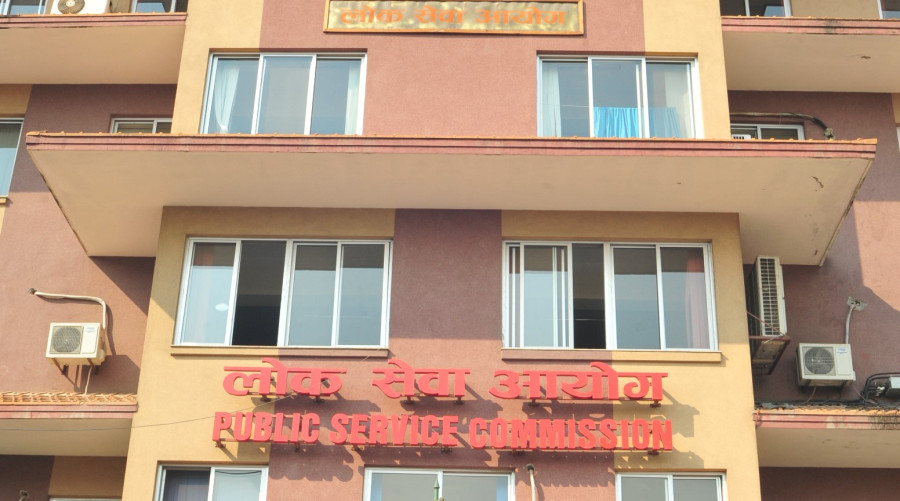National
Brahmins and Chhetris continue to dominate entry into civil service
Despite reservation policies for marginalised groups, Brahmins and Chhetris have not just maintained their dominance but have increased their presence in civil service.
Prithvi Man Shrestha
Brahmins and Chhetris continue to be disproportionately represented in Nepal’s civil service despite a 2007 Act mandating reservations for marginalised groups to increase their presence in the state apparatus.
In the last fiscal year 2018-19, Brahmins and Chhetris together made up 55 percent of all candidates recommended by the Public Service Commission, according to the commission’s annual report, published recently.
The commission had recommended a total of 4,574 candidates for recruitment into government service. Of the total, 34.87 percent were from the Hill Brahmin backgrounds, although their share of the population is just 12.2 percent, as per the 2011 Census. Chhetris constituted 19.63 percent of total entrants.
Despite reservation policies, the composition of the civil service has not changed drastically in recent years. The share of Brahmins and Chhetris, long dominant in state affairs, has grown, according to the commission’s data. The share of new recruits from these groups in the fiscal year 2016-17 was 41.63 percent, which rose to 53.4 percent in the fiscal year 2017-18, rising even higher in the last fiscal year.
“But if you look at the last seven years, you can also see the growing representation of communities other than Brahmins and Chhetris,” said Ananda Raj Dhakal, secretary at the commission.
In line with the commitments made by the major political parties for inclusive development, while ending the decade-long Maoists insurgency and the subsequent Madhes movement, the Civil Service Act was drafted with provisions for reservations for women and various marginalised communities. As per the Act, 70 percent of vacant posts are filled through open competition while 30 percent is filled through promotions for section officers. From among section officers, 45 percent is set aside for a separate competition among different clusters of communities for the purpose of inclusion.
As per the law, there is a 33 percent quota for women, 27 percent for indigenous nationalities, 22 percent for Madhesis, 9 percent for Dalits, 5 percent for the disabled, and 4 percent for backward regions. The remaining 55 percent of seats are filled through open competition.
Since the policy was adopted, officials and rights groups have acknowledged the rising presence of marginalised communities in state organs, but their share is still lower than their percentage of the population.
For instance, Tharus constitute 6.6 percent of the population, according to the census. But, in the fiscal year 2018-19, Tharus made up just 3.91 percent of entrants into civil service. Likewise, Magars constitute the third largest group after Chhetris and Brahmins, representing 7.1 percent of the total population. But, Magars only made up 5.03 percent of total recruits into civil service last fiscal year.
When it comes to women’s representation, their presence in civil service was 11 percent in the fiscal year 2007-08, which increased to around 25 percent in the fiscal year 2018-19, according to the Department of Civil Personnel Records.
But despite a narrower space for Brahmins and Chhetris, the two communities continue to maintain their disproportionate shares in the civil service, which could be attributed to their larger percentage of applicants.
Of the total 143,480 people who applied for the civil service jobs in the last fiscal year, 27.71 were from the Brahmin community and 13.47 percent from Chhetris, according to the commission.
“The high number of applicants from Brahmins also increased chances of getting recruited,” said Dhakal. “Candidates from these groups also possibly demonstrated better capacity, compared to candidates from other communities, as the commission recommends only the best candidates for recruitment.”
Officials, experts and right activities also point out that the dominant position of these two groups in civil service creates a favourable environment for their families and relatives to take part in and pass the civil service exams.
When one person in the family is in the civil service, they encourage other family members to take part, according to former chief secretary Bimal Koirala.
Koirala also pointed out that the medium of the exams is the Nepali language, which favours these dominant communities as their mother tongue tends to be Nepali.
“Courses for the exam are related to governmental work, which Brahmins and Chhetris tend to have a greater understanding of because of their dominant position in civil service. So despite being academically sound, candidates from other communities might score lower in the exam,” said Koirala.
According to Shanta Raj Subedi, former chairman of the National Inclusion Commisison, the continuing historical presence of Brahmin and Chhetri communities in public administration was the primary reason behind candidates continuing to score high in recruitment, despite the reservation policy.
“Brahmins don’t have a sizable presence in the army and police, like in civil service. You can see a high percentage of indigenous nationalities in the Nepal Army because of the historical tendency to enter the army,” he said.
Rights groups have been demanding more specific quotas to address this imbalance. Reservations for broad groups like women and the disabled should be further broken down into indigenous nationalities, Madhesi, Muslims and Dalits, they say.
“Even within women, candidates from Brahmins and Chhhetris dominate during recruitment,” said Jagat Baram, chairman of the Nepal Federation of Indigenous Nationalities, an indigenous rights organisation.
According to Subedi, the law has provided a lot of space for the greater representation of marginalised communities in civil service because they can compete under both open and inclusion categories while Brahmins and Chhetris can only compete under the open category.
“Our focus should be on how to ensure the representation of poor people from marginalised communities. There has only been competition among relatively well-off people,” he said.




 19.12°C Kathmandu
19.12°C Kathmandu

%20(1).jpg&w=200&height=120)













